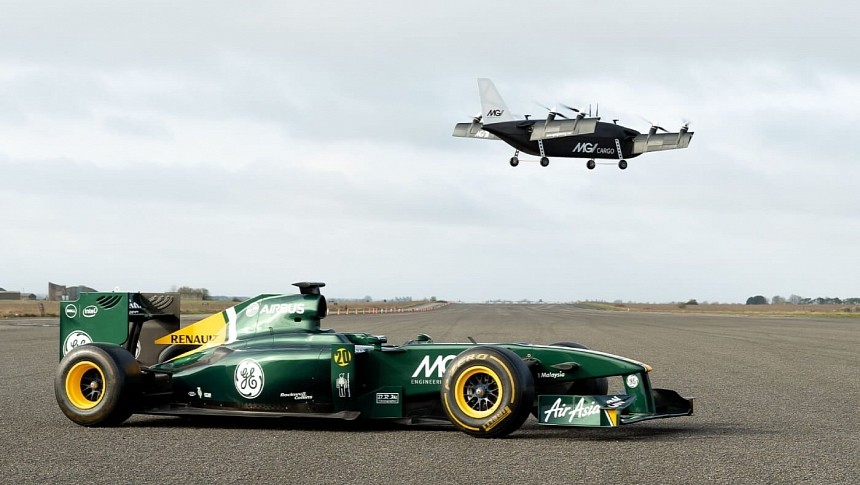What might be the connection between Formula 1 and electric cargo aviation? In the case of MGI Engineering it's related to one man – Mike Gascoyne. His extensive experience in the world of Formula 1 was the main inspiration behind an innovative eVTOL (electric vertical take-off and landing) concept.
Mike Gascoyne is swapping racing cars for electric flying cars. This British designer and engineer has worked with multiple Grand Prix teams for over 20 years, culminating with the launch of an F1 team from scratch. In 2009, when this happened, Gascoyne's company, MGI, was one of the few independent companies outside Formula 1 to have accomplished this.
Over the years, MGI Engineering has developed into an automotive consultancy company with expertise in composite materials. That's how the transition from Formula 1 to aviation occurred. The company first dived into the world of eVTOLs back in 2018. Last year, it marked the first flights of its cargo eVTOL demonstrators in Oxfordshire. Earlier this year, another milestone took things further with the successful full transition from vertical to horizontal flight.
This month, it was time for the eVTOL technology demonstrator to make its official debut. MGI Engineering introduced the Mosquito autonomous cargo UAV (uncrewed aerial vehicle) at the eVTOL Insights Conference in London.
This cargo concept claims to boast two main benefits. First, it's based on a configurable design that leads to two different aircraft variants. The first one is fitted with two rotors on each corner that can tilt from 45 degrees forward to 45 degrees rearward. The second variant combines eight rotors with direct-drive motors that are distributed across the four wings.
The main difference between them is that the second variant can take off vertically and then transition to horizontal flight, like an airplane, making it more efficient for long-distance operations.
The basic idea is that both variants share a common platform and the same battery modules – a concept that was inspired by the automotive industry. When it comes to commercial operations, this allows for future cargo aircraft to boast different configurations depending on the specific mission profile.
In addition to this modular approach, what makes the MGI Engineering cargo eVTOL more powerful is the use of composite structures. This is meant to make the aerial vehicle ultra-lightweight for greater cargo capacity and improved performance.
So far, the fully-functional demonstrator of the MGI Engineering eVTOL has passed all the necessary tests. The goal is to introduce it as a clean, high-performance alternative to multi-role aircraft, ready to handle anything from simple mail delivery to disaster relief and environmental research. This is what happens when a passionate F1 engineer applies his knowledge to an emerging sector in the aviation industry.
Over the years, MGI Engineering has developed into an automotive consultancy company with expertise in composite materials. That's how the transition from Formula 1 to aviation occurred. The company first dived into the world of eVTOLs back in 2018. Last year, it marked the first flights of its cargo eVTOL demonstrators in Oxfordshire. Earlier this year, another milestone took things further with the successful full transition from vertical to horizontal flight.
This month, it was time for the eVTOL technology demonstrator to make its official debut. MGI Engineering introduced the Mosquito autonomous cargo UAV (uncrewed aerial vehicle) at the eVTOL Insights Conference in London.
This cargo concept claims to boast two main benefits. First, it's based on a configurable design that leads to two different aircraft variants. The first one is fitted with two rotors on each corner that can tilt from 45 degrees forward to 45 degrees rearward. The second variant combines eight rotors with direct-drive motors that are distributed across the four wings.
The main difference between them is that the second variant can take off vertically and then transition to horizontal flight, like an airplane, making it more efficient for long-distance operations.
The basic idea is that both variants share a common platform and the same battery modules – a concept that was inspired by the automotive industry. When it comes to commercial operations, this allows for future cargo aircraft to boast different configurations depending on the specific mission profile.
In addition to this modular approach, what makes the MGI Engineering cargo eVTOL more powerful is the use of composite structures. This is meant to make the aerial vehicle ultra-lightweight for greater cargo capacity and improved performance.
So far, the fully-functional demonstrator of the MGI Engineering eVTOL has passed all the necessary tests. The goal is to introduce it as a clean, high-performance alternative to multi-role aircraft, ready to handle anything from simple mail delivery to disaster relief and environmental research. This is what happens when a passionate F1 engineer applies his knowledge to an emerging sector in the aviation industry.







